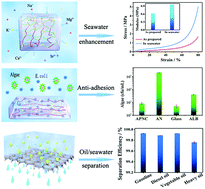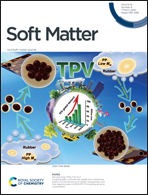Seawater-enhanced tough agar/poly(N-isopropylacrylamide)/clay hydrogel for anti-adhesion and oil/water separation†
Abstract
Hydrogels as typical hydrophilic materials are promising candidates for designing novel functional materials for anti-fouling, oil/water separation, wearable devices, tissue scaffolds, etc. However, it still remains a challenge to design stable and tough hydrogels for applications in complex environments of high stress, temperature, salt, and pH. Herein, we fabricate a novel seawater-enhanced Agar/Poly(N-isopropylacrylamide)/clay hydrogel (APNC gel) through a facile photo-initiated polymerization process. The APNC gel consists of fully interpenetrating double networks with negatively-charged clay serving as physical cross-linkers. The resulting gel exhibits tough mechanical strength (tensile strength of 0.85 MPa and compression strength of 1.68 MPa) and excellent stabilities for high temperature (100 °C) and high salt levels (20 wt% NaCl). Especially, the strength of the APNC gel is greatly enhanced (up to 5.04 MPa) by seawater, which contains numerous inorganic ions (Mg2+, Na+, K+, etc.). Meanwhile, the APNC gel presents excellent anti-adhesion performance due to the negatively-charged clay. Thus, a hydrogel-coated mesh with underwater superoleophobicity has been designed for oil/seawater separation. The resulting mesh can selectively remove oil from seawater with high separation efficiency (up to 99%). These characteristics demonstrate that the tough APNC gel will be an ideal material candidate for developing functional materials applied in a complex environment.

- This article is part of the themed collection: Soft Matter Most Popular 2020


 Please wait while we load your content...
Please wait while we load your content...